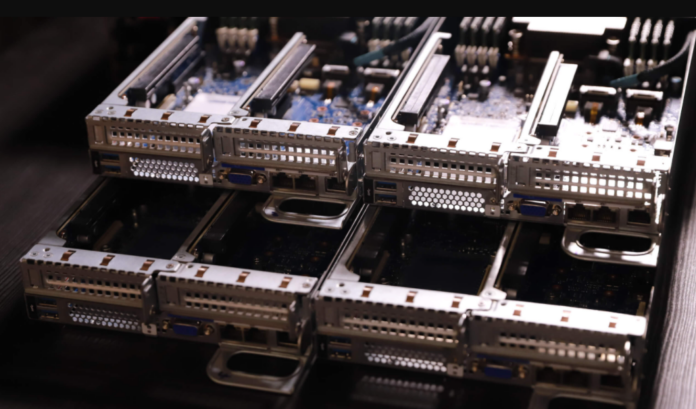Many firms are migrating to a multi-node server due to the high dependability and efficiency of their operations.
In general, using a multi-node server in the workplace helps to ensure high performance and uptime, maintain security, and allow for more efficient resource allocation. There are numerous other advantages to distributing resources among multiple nodes, each of which runs a different operating system.
You should employ a multi-node server system for your firm for a variety of reasons.
What is the Definition of Node?

In a data transmission network, a node is a point of intersection and connection. These devices are all considered nodes in an environment where all systems are accessible via the network. The type of network each node corresponds to determines the node’s particular definition.
Nodes generate, receive, and transmit data, which they either store or relay to other nodes. A scanner in a computer network, for example, generates images and delivers them to a computer. In contrast, a router organizes and distributes data received from the internet to the network’s different devices.
Nodes operate on various levels, but they are the key nodes via which internet traffic is often directed in the broadest sense. Because these same internet nodes are also known as internet nodes, this usage is a little misleading.
However, in the context of an office or home network, a node is merely one of the devices that performs a specific task. As a result, losing that node usually means losing functionality, such as being unable to print. Individuals can use cables (wired network) or other wireless technologies such as communication satellites, terrestrial microwave, Bluetooth, or Wi-Fi to connect the network nodes.
What is a Multi-Node Server?

A multi-node server is a framework that comprises a node that houses at least two separate computer servers (or nodes) that share a power supply. The common power supply disseminates the absolute power accessible to all nodes. A multi-node server is planned and developed in an isolated and enclosed area with no hot-swappable parts.
Benefits of Multi-Node Server
Here are some of the most significant advantages of working in a multi-node server setting.
1. Resource Management

Your server setup has a significant impact on how you monitor your resources, data, and systems. The use of Multi-node servers provides better resource management. Monitoring functions and resources are critical for every organization to ensure improved performance and efficiency.
However, granular interpretation often aids in ensuring maximum uptime and better performance, security, and, in most situations, more competent resource allocation to numerous systems. Splitting functions across multiple nodes, as well as deploying separate operating systems on the servers, might yield innumerable benefits.
The proper monitoring of resources is critical for fast-growing businesses or even startups with a rising business plan. As a result, it can be claimed that Multi-node servers are the better solution for large enterprises looking to increase their node server setup and resource monitoring.
2. High Performance
Multi-node servers, which pack numerous nodes in a single server case, can provide a lot of processing power in a tiny container. Because of their unique architecture, these high-performance systems save a lot of space in data centers, server rooms, and other places. A multi-node server houses two or more nodes in a single case, allowing for maximum performance. Multi-node servers are the only method to get better performance per height unit.
Redundant power supply modules ensure excellent dependability and availability, while energy-efficient cooling is provided by optimum ventilation. Dense multi-node systems, which use cutting-edge technology, are incredibly powerful and efficient, as well as inventive and future-proof. For exceptional multi-node server solutions, visit COTT Servers.
3. Increased Security

As technology advances and businesses become more digital, the threat of data and resource security grows. Online security is a big worry for any organization since if your data and resources are not safe, your business is always at risk.
One of the most beneficial aspects of employing a multi-node server is that it improves protection against cybersecurity and other data security risks. When using a multi-node server for resource allocation, your data is kept separate from the core node servers. So, if one of the node servers is attacked, the database and other resources will remain unaffected.
On the other hand, if you use all your resources on the same node servers, a virus or a hacker attack can cause irreparable damage, and you may lose your data as a result of resource exploitation.
Companies that deal with confidential data, such as banks, should adopt a multi-node server by separating the database from the servers. Dividing the databases would keep your information safe and secure, and in the event of a cyber-attack, a hacker would be unable to access your database.
The multi-node server is recommended for large and developing enterprises to ensure increased protection and safety of their data and resources.
4. Cost-Effectiveness
You should be aware that server upgrades raise the overall cost, but not consistently. Suppose you are experiencing challenges with server performance, particularly in terms of resources such as RAM or CPU. In that case, a multi-node server setup is a more cost-effective way to boost performance than replacing the system. If you can’t afford extra servers or don’t have enough RAM, spreading your functions across different servers will help you maximize resources and alleviate any performance concerns.
Separating resources from servers allows you to execute all functions tasks independently, and it’s one of the most cost-effective strategies to get the most out of your server setup. Businesses can increase system reliability while lowering costs in specific cases. Database and application or web server needs and duties are somewhat distinct, and breaking them apart would be quite beneficial.
A multi-node server setup allows you to have more services and connections, helps to keep the system up and running by reducing resource dependency on a single system, and is also less expensive each month than constantly adding resources to the server. Compared to the most influential node server arrangement accessible, two or three nodes in the lower price level range provide service-oriented features.
Conclusion
In this post, we’ve discussed some of the primary advantages of employing a multi-node server system, as well as how it may help your company achieve long-term stability and success.







